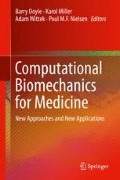Abstract
Clinical evaluation of the mechanical condition in musculoskeletal soft tissues is challenging due to the wide range in morphology, size, and function of the anatomical structures. Virtual biomechanical simulations in 3D anatomical models reconstructed from medical imaging provide an instrument to receive feedback on realistic mechanics and deformation, but require an adequate computational representation of the anisotropic fibrous architecture. In this study, we investigate the application of a Laplacian based approach as a collective basis to generate fiber bundle orientations in 3D anatomical models of the various musculoskeletal soft tissue structures. Methodological adaptations for specific cases are evaluated, while feasibility is demonstrated in anatomical examples of muscles and joint connective tissue structures.
Access this chapter
Tax calculation will be finalised at checkout
Purchases are for personal use only
References
Blemker, S.S., Delp, S.L.: Three-dimensional representation of complex muscle architectures and geometries. Ann. Biomed. Eng. 33(5), 661–673 (2005)
Weiss, J.A., Gardiner, J.C., Ellis, B.J., et al.: Three-dimensional finite element modeling of ligaments: technical aspects. Med. Eng. Phys. 27(10), 845–861 (2005)
Kim, S.Y., Boynton, E.L., Ravichandiran, K., et al.: Three-dimensional study of the musculotendinous architecture of supraspinatus and its functional correlations. Clin. Anat. 20, 648–655 (2007)
Klimstra, M., Dowling, J., Durkin, J.L., et al.: The effect of ultrasound probe orientation on muscle architecture measurement. J. Electromyogr. Kinesiol. 17, 504–514 (2007)
Longwei, X.: Clinical application of diffusion tensor magnetic resonance imaging in skeletal muscle. Muscles Ligaments Tendons J. 3(2), 58–59 (2012)
Kermarrec, E., Budzik, J.F., Khalil, C., et al.: In vivo diffusion tensor imaging and tractography of human thigh muscles in healthy subjects. AJR Am. J. Roentgenol. 195, W352–W356 (2010)
Belvedere, C., Ensini, A., Feliciangeli, A., et al.: Geometrical changes of knee ligaments and patellar tendon during passive flexion. J. Biomech. 45, 1886–1892 (2012)
Blankevoort, L., Huiskes, R., de Lange, A.: Recruitment of knee joint ligaments. J. Biomech. Eng. 113, 94–103 (1991)
Taylor, Z.A., Kirk, T.B., Miller, K.: Confocal arthroscopy-based patient-specific constitutive models of cartilaginous tissues – I: development of a microstructural model. Comput. Meth. Biomech. Biomed. Eng. 10(4), 307–316 (2007)
Taylor, Z.A., Kirk, T.B., Miller, K.: Confocal arthroscopy-based patient-specific constitutive models of cartilaginous tissues – II: prediction of reaction force history of meniscal cartilage specimens. Comput. Meth. Biomech. Biomed. Eng. 10(5), 327–336 (2007)
Hirokawa, S., Tsuruno, R.: Three-dimensional deformation and stress distribution in an analytical/computational model of the anterior cruciate ligament. J. Biomech. 33(9), 1069–1077 (2000)
Lu, Y.T., Zhu, H.X., Richmond, S., et al.: Modelling skeletal muscle fibre orientation arrangement. Comput. Methods Biomech. Biomed. Eng. 14(12), 1079–1088 (2011)
Erdemir, A.: Open knee: a pathway to community driven modeling and simulation in joint biomechanics. In: Proceedings of the ASME/FDA 2013 1st Annual Frontiers in Medical Devices, Washington, DC, USA (2013)
Maurice, X., Sandholm, A., Pronost, N., et al.: A subject-specific software solution for the modeling and the visualization of muscles deformations. Vis. Comput. 25(9), 835–842 (2009)
Heimann, T., Chung, F., Lamecker, H., et al.: Subject-specific ligament models: toward real-time simulation of the knee joint. In: Computational Biomechanics for Medicine IV, pp. 107–119. Springer, New York (2010)
Wu, F.T., Ng-Thow-Hing, V., Singh, K., et al.: Computational representation of the aponeuroses as NURBS surfaces in 3D musculoskeletal models. Comput. Methods Programs Biomed. 88(2), 112–122 (2007)
Choi, H.F., Blemker, S.S.: Skeletal muscle fascicle arrangements can be reconstructed using a laplacian vector field simulation. PLoS One 8(10), e77576 (2013)
Greis, P.E., Bardana, D.D., Holmstrom, M.C., et al.: Meniscal injury: I. basic science and evaluation. J. Am. Acad. Orthop. Sur. 10(3), 168–176 (2002)
Geuzaine, C., Remacle, J.F.: Gmsh: a three-dimensional finite element mesh generator with built-in pre- and post-processing facilities. Int. J. Numer. Methods. Eng. 79, 1309–1331 (2009)
Heemskerk, A.M., Sinha, T.K., Wilson, K.J., et al.: Quantitative assessment of DTI-based muscle fiber tracking and optimal tracking parameters. Magn. Reson. Med. 61(2), 467–472 (2009)
Maas, S.A., Ellis, B.J., Atheshian, G.A., Weiss, J.A.: Febio: finite elements for biomechanics. J. Biomech. Eng. 134(1), 011005 (2012)
Miranda, D.L., Rainbow, M.J., Leventhal, E.L., et al.: Automatic determination of anatomical coordinate systems for three-dimensional bone models of the isolated human knee. J. Biomech. 43(8), 1623–1626 (2010)
McKenney, A., Greengard, L.: A fast Poisson solver for complex geometries. J. Comput. Phys. 118, 348–355 (1995)
Wedmid, A., Llukani, E., Lee, D.I.: Future perspectives in robotic surgery. BJU Int. 108(6b), 1028–1036 (2011)
Acknowledgments
This work has been funded by the EU FP7 Marie-Curie ITN project MultiScaleHuman under Grant number 289897. We thank the University Hospital of Geneva in Switzerland, for providing the medical images, and the biomechanics laboratory LBB-MHH of the medical school in Hanover, Germany, for the experimental data of knee displacement.
Author information
Authors and Affiliations
Corresponding author
Editor information
Editors and Affiliations
Rights and permissions
Copyright information
© 2015 Springer International Publishing Switzerland
About this paper
Cite this paper
Choi, H.F., Chincisan, A., Magnenat-Thalmann, N. (2015). A Collective Approach for Reconstructing 3D Fiber Arrangements in Virtual Musculoskeletal Soft Tissue Models. In: Doyle, B., Miller, K., Wittek, A., Nielsen, P. (eds) Computational Biomechanics for Medicine. Springer, Cham. https://doi.org/10.1007/978-3-319-15503-6_11
Download citation
DOI: https://doi.org/10.1007/978-3-319-15503-6_11
Publisher Name: Springer, Cham
Print ISBN: 978-3-319-15502-9
Online ISBN: 978-3-319-15503-6
eBook Packages: EngineeringEngineering (R0)

